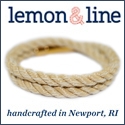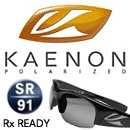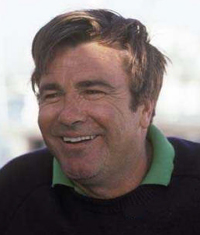
|
|
|
Scuttlebutt News: Ben Lexcen: A crazy lovable rouge by Blue Robinson (October 2, 2009) Ben Lexcen was a remarkable man who did much more than design Australia II, the boat that won the 1983 America's Cup, thus ending New York Yacht Club's 132 year winning streak in the event. As a reminder, here is an article on Ben I wrote for Seahorse magazine which appeared in August 2007:
He grew up without a Father, and being bundled from one relative to another by his Mother, finally fetching up in Newcastle, north of Sydney. There, living with a Grandfather, he attended school until he was 14; left to work at a metal foundry, then apprentice fitter and turner for the railways. Weekends were spent at the Newcastle and Lake Macquarie dinghy clubs, where he sailed dinghies and sixteen foots skiffs. Transferring from Newcastle to Sydney, he decided to become an apprentice sail maker, working for Peter Cole in Inner Sydney, where he "adopted' the Ryves family in 1956. Sleeping on the couch, he washed his trousers by wearing them in the shower, then ran around in them until they dried. His other passion was the harmonica - which he played in the shower whilst scrubbing his trousers. Carl Ryves was 14 when Bob arrived and they became lifelong friends, "My parents nourished him both physically and mentally. Mum of course fed him, and Dad had a library of technical books by Uffa Fox on yacht design and construction and Manfred Curry's incredible book with chapters on aircraft wings and yacht sails, the resistance of air and water, and nature as a guide to the construction of a sail. Just as important my parents had friends who were the directors of art galleries, senior genetics researchers, scientists, and people like Archie Middleton, the surgeon that separated Siamese twins." Ben devoured the yachting books and was fascinated with the intellectual and range around the dinner table. One thing is for sure, throughout his whole life Ben looked at things, and wondered. In 1958 he fell 40 feet from the top of a mast and broke his back. A friend and boat builder Norm Wright took in a small drawing board and a set of cedar curves to use while still in hospital. The results were the 18 footer's Taipan & Venom. When the existing skiffs were heavy and carried five crew, Taipan had three, two on trapeze. Miller was working on the problems of tip vortex so he fitted small wings on Taipan's centerboard and rudder (also on his 5.5 metre, Catamaran and Moth). He removed them from the centerboard after problems launching the boat in the river mud and jellyfish getting snagged, but kept them on the rudder that could be cleaned whist sailing. When Taipan begun beating opposition 18 footers by 12 minutes on an 11-mile course, it caused howls of protest, and claims the boat was not legal and it should be banned - phrases he was going to hear again in 1983. Bob teamed up with Craig Whitworth to form the sail making and design company Miller and Whitworth, both being named Yachtsmen of the Year in 1964 for winning the State, National and inter-Dominion titles in the Flying Dutchman. Bob skippered a Soling in the 1972 Olympics, designed the Contender single-handed dinghy, Admirals cup yachts Apollo II, Ginkgo, and Mercedes III (best individual boat in the 1967 series), plus Ballyhoo which beat Kialoa in the California Cup and San Francisco perpetual trophy races. During the business split with Craig Whitworth in 1974, Ben chose a new name, so Bob Miller became Ben Lexcen. The America's cup yachts began with Alan Bond's Southern Cross in 1974, then co - designed Australia in 1977, which also raced (modified) in 1980, Challenge 12 and Australia II in 1983, and Australia III & IV in 1987. Southern Cross was a long boat with too little sail area, and Australia had a problem with her hull shape at around nine knots. Lexcen altered the bustle, and the boat improved. Crewmember John "Chink" Longley who first sailed with Lexcen in 1971 remembers, "Benny was very intuitive. He knew there was a problem with the bustle, he knew the shape was wrong, and knew the shape it had to be, so he just fixed it. When we sold it to the British team, they later told me it was the best twelve they had!" The big story for 1980 was the mast. The British boat Lionheart sailed with a bendy rig, allowing a larger mainsail. Lexcen saw this, and armed with a few photos but no plans, he and a small team cut their spare mast off at the hounds and scarfed a long fiberglass section on top. John Bertrand remembers, "When we sailed with it the first day, we sheeted the mainsheet on and the mast bent, and bent and bent, and the sectional shapes in the sail were almost perfect - an extraordinary feat when the mast stiffness had to be calculated relative to balance out the leech tension. That one hit - and thatís all we had time for, was an extraordinary design solution by Ben in collaboration with Tom Schnakenberg." Added John Longley, " We sprayed it silver and got it measured and signed off, then had four days to put it in and make it work which we did - but it was mayhem. After a long day of fitting it we wound the backstay on hard to test it overnight, then floodlit this great 'hockey stick' of a mast to show the Americans. The next day the New York yacht Club was onto us like a flash, saying, "We can't use it, itís not measured!" So we waved the certificate at them and said, "Yes we can. This was Ben at his best, hands on, quick accurate sketches, whilst on the job, and we trusted him. We knew it would work." The model testing for Challenge 12 and Australia II were done in the Netherlands ship basin in Holland - normally used for testing ship models. Said John Bertrand, "Ben saw the carriage system that was presented to him didn't give the refinement that was required in lift and drag, so surrounded by dozens of PHD engineers who had worked there for years, he re-designed the towing tank facility for his testing program so the towing point was the centre of effort on the sail plan. This was typical of Ben. He was a living, breathing developer of technology. For instance the mast on Australia II made Liberty's rig look like a farmers plough, Dennis Conner made that comment - he couldn't believe the refinement of the Australia II rig, so in every aspect of the boat, Ben's development was quite superb, in terms of the reduction of aerodynamic drag from the spreaders, the shroud attachment to the mast, the design of the head crane - not without their problems, we blew that up twice because Ben was interested in the power to weight ratio, the more weight carried the slower the boat, and total perfection for Ben was for the boat to implode into a million pieces once it had won the America's Cup. That is of course a design dream you don't want to go near, but that was Bennyís mentality to refine everything." It was the conventional shaped Challenge 12 that was worked on first, and only when that was completed did Ben use his time at the tank to try idea's he had thought about since 1957. Australia II emerged, but Challenge 12 was a quick boat. Noted John Bertrand, "The first time we sailed Australia II against Challenge 12 was off Fremantle in perfect 8-10 knots of breeze for about 12 miles upwind, and the two boats were locked together - you could tie a piece of string to them - then we gybed and sailed downwind and Challenge 12 wobbled away from us. That caused us to scratch our heads and we eventually solved it by working on the spinnakers. Remarked John Longley, " When Australia II's design was finished, and they did full scale lofting on big Mylar sheets on the floor from the original lines, I was there, and Benny spent about two weeks crawling over the lofting with his pen, just etching a bit here and there, intuitively adjusting it. The boat wasn't such a potent weapon from the point of view of the keel, but by time our whole package was refined we were pushing every edge we could - Benny wanted to push everything, so the keel was only a part of it, but the good thing about the keel was it became that absolute focus for the Americanís, so to them it wasn't our rig or sails or crew, just the keel." In 1984 pro surfer Cheyne Horan contacted Ben to discuss surfboards and fins. "The first thing Ben asked me when we met was how the relationship was with my parents," said Horan. "He always checked everything was OK, which it was, then he looked at my board changing the design, putting a rail release in the top third of the board, it was a 'V' that released the front rail allowing the board to travel faster through the water. We also worked on a fin for the board that is called the Starfin, that has wings on, I still use it, and it hasn't changed in 22 years. Ben explained that the angles in the Starfin had to be correct, so that when the pressure moved down the stem of the fin, the pressure was used before it got to the tip. The fin was fast! I used it against guys like Kelly Slater (now nine times World champion) and down the line speed it was faster. Ben KNEW how water worked, how shapes moved through water, he was always into speed. When I said he should have the royalties from the Starfin Ben declined, saying 'No you keep that'. An incredible guy, without doubt a genius." According to Bertrand, "He didn't have the normal process of decision making that formally educated people had, he was a walking talking ideas man. I have undergraduate and post graduate degrees in engineering, and from that 'formal' platform it became clear to me whilst working with Ben just how brilliant he really was, the rigging details in Australia II's mast were just sensational, as were the boom and pole development." Ben was inducted into the America's Cup Hall of Fame on October 26, 2006, yet there is still a minority that claim he didn't design Australia II, as he had no "formal" education. Bruce Farr (much to his headmaster's annoyance) left school at 16, and the master himself Olin Stephen's left MIT after one term (due to yellow fever), choosing not to return. Nobody questions these brilliant individuals natural ability. Good humored, generous, amusing, mischievous with a sharp analytical and intuitive mind, Warren Jones said, "We pay Ben to dream", John Bertrand called him "A crazy lovable rouge that would have people laughing and spellbound at the same time." The final word about his most famous creation, the winged keel should go to Ben himself. In 1983 he said, "I have in mind to admit it all to the New York Yacht Club that I really owe the secret of the design to a Greek guy who helped me out and was invaluable. He's been dead for 2000 years, bloody Archimedes..." © Blue Robinson back to top |







|


